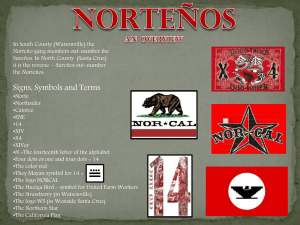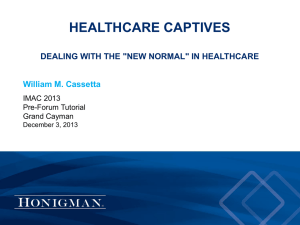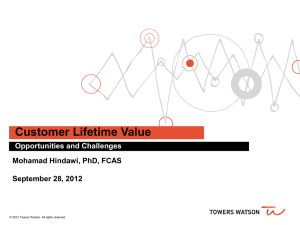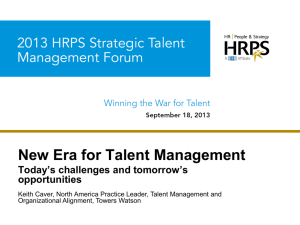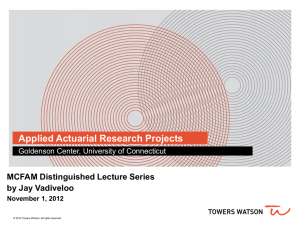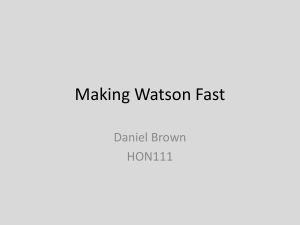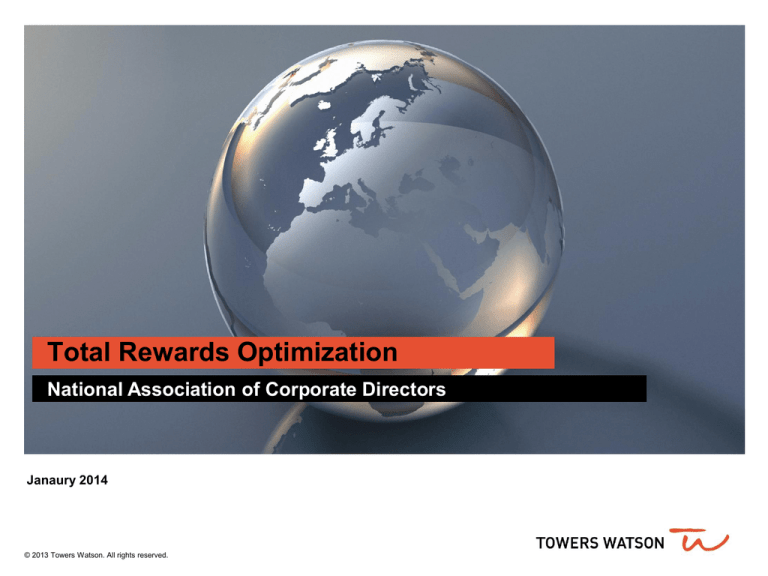
Total Rewards Optimization
National Association of Corporate Directors
Janaury 2014
© 2013 Towers Watson. All rights reserved.
Total Rewards Optimization (TRO) is designed to inform
Directors on whether the organization is making the most
efficient use of corporate resources
Total $ Investment in Employees
Recognition
Manager Effectiveness
Equity
Training
What is the best level of
investment in employees?
Retirement
Base Pay
Paid Time Off
What is the best allocation
of that investment to maximize
engagement?
Do the answers vary by employee
segments, units, or other
demographic characteristics?
Dental
Medical
Benefits
Variable
Pay
towerswatson.com
© 2013 Towers Watson. All rights reserved. Proprietary and Confidential. For Towers Watson and Towers Watson client use only.
1
TRO combines conjoint analysis with financial
optimization
Optimum Level
of Investment
Conjoint
Analysis
Is a surveying method
used for many years in
marketing to capture
subjective preferences
Asks employees to
make trade-offs among
program features as
opposed to assessing
the features individually
Is a more reliable
forecast of behavior
than traditional survey
methods
Portfolio
Optimization
Reflects cost constraints
on investment
Develops an efficient
frontier of optimum
allocation of investments
Determines optimum
investment level on the
basis of program costs
and turnover cost
savings
Optimum Allocation
of Investment
Segment-Specific Strategy
Optimum solution may be to:
Improve engagement/motivation
by changing allocation while
maintaining the current level of
investment
Maintain current level of
engagement/motivation at lower
level of investment by changing
allocation
Increase investment and
engagement/motivation to
economically efficient level
2
towerswatson.com
© 2013 Towers Watson. All rights reserved. Proprietary and Confidential. For Towers Watson and Towers Watson client use only.
Compared to a traditional survey, TRO provides richer
data insights to better inform programmatic decisions
Directional information on understanding and
importance of programs
Information on employee awareness and
understanding of current programs
Quantitative information on the most important
rewards
Accurate information on various employee
segments
Data and analysis on how specific rewards
changes/trade-offs will affect employees
Data and analysis on what specific rewards
changes will cost
ROI for specific rewards changes or
reallocations
Ability to test cost-benefit of different rewards
and demographic scenarios with modeling
tool
Focus
Groups
Traditional
Survey
Conjoint
Survey
Total Rewards
Optimization
3
towerswatson.com
© 2013 Towers Watson. All rights reserved. Proprietary and Confidential. For Towers Watson and Towers Watson client use only.
TRO “optimizes” employee preferences with investment
implications
Increase in Indicated Engagement from Current Level
(Percentage)
3) Increase investment
and increase
engagement
Change in Engagement
40%
2) Maintain current
level of investment
while increasing
engagement
30%
1) Maintain current
level of
engagement
at lower investment
20%
Current levels of
engagement and
reward investment
10%
–$20mm –$10mm
Decrease in investment from
current level
0
$10mm $20mm $30mm
Increase in investment
from current level
Three Points on the Curve
Each point along the curve
represents the best allocation of
the corresponding total
investment:
1. To reduce total cost, the
curve identifies which
programs should be reduced
to reallocate investments in
other areas and maintain
current levels of engagement
2. To maintain current
investment levels, the curve
identifies how to reallocate
investment across programs
to increase engagement
without raising cost
3. To increase engagement
dramatically and make the
most of each reward dollar,
the curve indicates the best
ways to invest additional
rewards funds
4
towerswatson.com
© 2013 Towers Watson. All rights reserved. Proprietary and Confidential. For Towers Watson and Towers Watson client use only.
Example: Trade-off questions
In the conjoint section of the survey, employees are presented a series of
combinations of reward elements
These questions, presented as pairs (or trios) of elements which elicit trade-offs,
determine the respondents’ preferences
The respondent will be asked to rate his or her preference for two different
combinations of rewards, holding all other things equal
Survey questions vary for each respondent based on their responses to prior
survey questions
EXAMPLE
If these two combinations were identical in all other ways, which would you prefer?
Your annual merit pay increase opportunity is increased
to x%
Your annual merit pay increase opportunity remains
unchanged at x%
The company contribution to your retirement plan is
reduced by x% of your eligible pay
The company contribution to your retirement plan is
increased by x% of your eligible pay
5
towerswatson.com
© 2013 Towers Watson. All rights reserved. Proprietary and Confidential. For Towers Watson and Towers Watson client use only.
Example: Portfolio questions
EXAMPLE
How motivated are you to perform consistently at your highest level to help ABC
Company fulfill its mission if your rewards package included the following?
ABC Company increases its investment in flexible work options by 20% to improve
programs. Programs/policies will be applied more consistently, with management support
Your annual merit pay increase opportunity is increased to x%
The company contribution to your retirement plan is reduced by x% of your eligible pay
You receive 5% more than current annual base pay (with ongoing annual increase
opportunity)
No change in your supervisor’s effectiveness
Please indicate how motivated you are to perform consistently at your highest level to help ABC Company
succeed on a scale of 0 to 100 where:
0 represents "Not At All Motivated"
100 represents "Very Highly Motivated"
6
towerswatson.com
© 2013 Towers Watson. All rights reserved. Proprietary and Confidential. For Towers Watson and Towers Watson client use only.
Research Output Example: Areas of Highest Perceived
Value Improvements and Cost Implications
•
In this example, increasing base pay and implementing a volunteering leave would yield
the highest improvements in perceived value
Change in
Reward Cost
Improvements in Perceived Value
5.4
Base pay: Increases by 5%
Volunteering leave: Four weeks paid for full-time
volunteering program after two years of service
3.7
$24M
$5M
AIP: Increases five percentage points
3.5
$20M
LTI: Increases by 25%
3.5
$25M
2.7
Pension contribution: Increases by 3% of pay
2.0
Medical premiums: Decreases by 20%
Wellness: Additional $1,000/employee
Convenience: Additional $1,500/employee
1.5
1.3
$10M
$2M
$4M
$6M
7
towerswatson.com
© 2013 Towers Watson. All rights reserved. Proprietary and Confidential. For Towers Watson and Towers Watson client use only.
Research Output Example: Areas of Highest Perceived
Value Declines and Cost Implications
•
In this example, highest levels of negative sensitivity are a decrease in base pay and a
full-replacement HDHP and HSA
Change in Reward
Cost
$(24)M
$(2)M
$(10)M
$(50)M
$(20)M
Declines in Perceived Value
Base pay: Decreases by 5%
-12.0
Medical plan options: HDHP and HSA replaces
PPO
-10.0
-9.0
Pension contribution: Decreases by 3% of pay
-8.0
LTI: Grant value reduced by 50%
AIP: Decreases five percentage points
-7.0
$(2)M
-6.5
Medical premiums: Increases by 20%
$(4)M
-6.4
Medical OOP costs: Increase by $700 per
individual ($1,500 per family)
$-
-3.0
Medical plan options: HDHP and HSA added
8
towerswatson.com
© 2013 Towers Watson. All rights reserved. Proprietary and Confidential. For Towers Watson and Towers Watson client use only.
VP’s and Above:
There are opportunities to reallocate expenditure to increase the
return on compensation investments
Program Change
Impact on Satisfaction (baseline = 72%)
Cash award where you receive 75% of the usual stock option value in cash over a period of time (e.g., 3 years)
11.2%
Cost Impact
$29,352,438
Restricted stock program where the number of shares granted is equal to 1/3 of the usual number of stock options
9.5%
granted
Performance-based restricted stock program where the number of shares granted is equal to ½ of the usual number of
8.5%
stock options granted
8.2%
Opportunity to receive up to 25% more of actual annual bonus based on individual performance
Cash award where you receive 50% of the usual stock option value in cash over a period of time (e.g., 3 years)
7.7%
Restricted stock program where the number of shares granted is equal to 1/4 of the usual number of stock options
6.8%
granted
5.5%
Performance-based restricted stock program where the number of shares granted is equal to 1/3 of the usual number of
$36,900,208
$55,909,406
$1,290,217
$19,568,292
$27,954,703
$36,900,208
stock options granted
25% more than the current annual bonus target
Opportunity to receive up to 15% more of actual annual bonus based on individual performance
$4,300,724
4.6%
$774,130
25% more than the usual merit increase
2.5%
$488,719
25% more than the usual stock option grant value
2.4%
$9,784,146
25% less than the usual stock option grant value
25% less than the usual merit increase
25% less than the current annual bonus target
No stock option grant
$(9,784,146)
-3.4%
$(488,719)
-5.3%
$(4,300,724)
-6.1%
$(39,136,584)
-7.3%
-14% -12% -10% -8% -6% -4% -2%
* Individual impact on satisfaction assumes all other programs remain at current state (individual impact results are not additive).
towerswatson.com
4.8%
0%
2%
4%
6%
8% 10% 12% 14%
9
© 2013 Towers Watson. All rights reserved. Proprietary and Confidential. For Towers Watson and Towers Watson client use only.
Optimization Analysis VPs and Above
Considering the objectives of maintaining a focus on shareholder value, greater alignment with
competitive trends and higher perceived value for VPs, ABC may want to consider:
A 50%/50% mix between stock options and restricted stock and
Increased bonus up to 25% based on individual performance
Restricted stock will provide more direct alignment with shareholder value compared to cash and
higher perceived value then stock options
Modeled reward portfolios that would improve employee engagement and maintain/reduce cost
Reward Category
Option/RS
Base pay (annual
increase)
Unchanged
ABC is currently competitive
and should not add fixed pay
Annual Bonus Target
Unchanged
Currently competitive on TCC
basis
Up to 25% more bonus
based on individual
performance
Individual bonus is key
satisfaction and performance
driver – lower cost element
Annual Bonus
(Individual
performance)
Long-term Cash
No program
No ownership value
Performance based
Restricted Stock
No program
Not as highly perceived as
restricted stock
Restricted Stock
Stock Options
Reward Cost Impact
($000)
Satisfaction Impact
towerswatson.com
Rationale
¼ exchange (50% of
options)
Reduced by 50%
-$8.3M
+11.2%
Lower cost – higher perceived
value than 100% options
Legacy program
10
© 2013 Towers Watson. All rights reserved. Proprietary and Confidential. For Towers Watson and Towers Watson client use only.
Understanding the impact of various changes to the
“portfolio”
ILLUSTRATIVE
Based on a current portfolio engagement score of 85.6
Reward
Portfolio #1
Portfolio #2
Portfolio #3
Premiums +15% for not
participating
Premiums -5% for
participating
Premiums -5% for
participating
Medical and Pharmacy
Cost
Current
Current
Current
Merit Pay
Current
Current
Current
Reduced to 50% of pay,
with option to buy
increased levels
Eliminated, buy option
replacing 67% of pay
Reduced to 50% of pay,
with option to buy
increased levels
Eliminated
Current
Current
Buy up to 40 hours
Buy up to 40 hours
Buy up to 40 hours
Career Development
Current
Online career tools
Increased manager
training
Tuition Assistance
Current
Includes certifications
Current
5% match
5% match
5% match
Portfolio Engagement
79.1
88.2
89.6
Change in Engagement
-6.5
+2.6
+4.0
-$23.9M
-$12.0M
-$0.5M
Wellness
Short-Term Disability
Employee Incentive Plan
Paid Time Off
401(k) Match
Change in Reward Costs
Program improvement
Program reduction
11
towerswatson.com
© 2013 Towers Watson. All rights reserved. Proprietary and Confidential. For Towers Watson and Towers Watson client use only.
While the research may point to the most efficient
portfolios, optimization overlays other factors including
business objectives and change management impact
Leadership
Strategy &
Rewards
Philosophy
Current spend
Cost/savings
of alternatives
Program
Costs and
Cost
Implications
Leadership interviews
Business Driver Analysis
Rewards Subject Matter Input
Total Rewards
Optimization
Supports reward philosophy and
business alignment
Meets cost constraints
Appropriately drives employee
attraction, engagement and
engagement of key segments
Competitive
Positioning Of
Rewards
Employee
Demographics
& Preferences
Conjoint survey
Employee
Comments
Demographic
analysis
Competitive Compensation
and Benefits Analyses and
Summaries
Prevalence of programs
12
towerswatson.com
© 2013 Towers Watson. All rights reserved. Proprietary and Confidential. For Towers Watson and Towers Watson client use only.
Total Rewards Measurement
13
towerswatson.com
© 2013 Towers Watson. All rights reserved. Proprietary and Confidential. For Towers Watson and Towers Watson client use only.
Why is total rewards measurement important?
Helps to track the return on reward investment decisions
Provides decision making framework for priorities and future investment
Serves as a link to performance management for HR
14
towerswatson.com
© 2013 Towers Watson. All rights reserved. Proprietary and Confidential. For Towers Watson and Towers Watson client use only.
Top 10 barriers to effective total rewards scorecards
1. Excessive number of measures
2. Difficulty establishing link between business and TR strategies
3. Absence of benchmarking data
4. Adoption of external benchmarking data as targets
5. Internal data to evaluate metrics are not readily accessible and/or not tracked
on consistent basis
6. Metric is within the control of a very limited number of people
7. Little room to improve measures
8. Metrics track completion/progress of organizational initiatives rather than the
achievement of the total rewards objective and business performance
9. Measures are unnecessarily complex and difficult to understand
10. Significant administrative resources required to maintain scorecard
15
towerswatson.com
© 2013 Towers Watson. All rights reserved. Proprietary and Confidential. For Towers Watson and Towers Watson client use only.
Total rewards scorecard considerations
Type of
Scorecard
Will the scorecard be standalone or part of a broader business scorecard?
Measures and
Weights
What measures will be tracked and communicated?
Should the measures be weighted? What are the weightings?
Level of
Measures
At what organization level should measures be tracked (i.e. corporate, LOB, geography,
function, department)?
How will standards be set (i.e. external benchmarks, internal budgets, statistical analysis,
growth)?
Should ranges used or a singular target?
Should measures be tracked annually, semi-annually, quarterly, monthly?
Should long-term forecasts be used?
How will the scorecard be used for business and people decision-making?
Should it be part of the annual planning process?
Should it be linked to pay decisions? Other talent management decisions?
Standards
Timing
Use
16
towerswatson.com
© 2013 Towers Watson. All rights reserved. Proprietary and Confidential. For Towers Watson and Towers Watson client use only.
5 steps for developing an effective total rewards
scorecard
Step 1
Define total rewards objectives
Step 2
Conduct diagnostics to identify areas of measurement
Step 3
Define metrics by total rewards objective
Step 4
Assign weights and develop performance standards
Step 5
Create action plans based on priorities
17
towerswatson.com
© 2013 Towers Watson. All rights reserved. Proprietary and Confidential. For Towers Watson and Towers Watson client use only.
26 Potential Indicators of TR Effectiveness (External,
Internal and Functional Metrics)
Externally focused
Revenue per employee
Expense per employee
Income per employee
Human capital ROI
Human capital value added
Customer satisfaction
Internally focused
Regular employee management ratio
Exempt turnover
Nonexempt turnover
Voluntary turnover
Engagement
Function-focused
HR FTE ratio
HR service score
Staffing
Cost per hire
Time to fill
Time to start
Accession rate
Internal accession rate
Rewards
Compensation per employee
Variable as a % of comp
Labor cost expense
Benefit cost per employee
Benefit cost as % of payroll
Health care cost per employee
Talent Management
Training hours per employee
Training cost per employee
18
towerswatson.com
© 2013 Towers Watson. All rights reserved. Proprietary and Confidential. For Towers Watson and Towers Watson client use only.
19
towerswatson.com
© 2013 Towers Watson. All rights reserved. Proprietary and Confidential. For Towers Watson and Towers Watson client use only.

